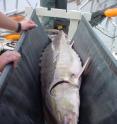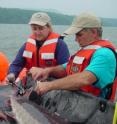Study provides data that can inform Atlantic sturgeon recovery efforts
Related images
(click to enlarge)
A first-of-its-kind study that tracked the oceanic migrations of adult Atlantic sturgeon that were caught and tagged in the Hudson River discovered that these fish move vast distances in the Atlantic Ocean, traveling as far south as Georgia and as far north as Nova Scotia, Canada. The findings indicate that recovery of Atlantic sturgeon fisheries will need to address long-range oceanic threats to the species in addition to local measures closer to spawning grounds. These results are particularly timely given the announcement on October 5 by NOAA's Fisheries Service, proposing that five populations of Atlantic sturgeon along the U.S. East Coast, including the population examined in this study, receive protection under the federal Endangered Species Act (http://www.nefsc.noaa.gov/press_release/2010/News/NR1025/index.html). The researchers used pop-up satellite archival tags (PSAT), which were affixed to sturgeon in their freshwater spawning grounds in the Hudson River. This relatively new technology enabled researchers to track fish movements over a larger area, and without the bias that can occur with other commonly used methods such as fixed acoustic arrays or fishery-dependent observations.
"This study of Atlantic sturgeon provides us with new insight into the very critical oceanic phase of the lives of these fish," said Dr. Ellen Pikitch, Executive Director of the Institute for Ocean Conservation Science at Stony Brook University and co-author of the study. "Effective restoration policies for sturgeon must consider threats to the species throughout their life cycle."
As is the case for most species of sturgeon, Atlantic sturgeon spawn in fresh water but spend the majority of their lives in the sea, A status review conducted in 2007 identified five Distinct Population Segments for Atlantic Sturgeon, which are genetically and ecologically distinct groups of fish.
"This research demonstrates Atlantic sturgeon from the New York Bight move widely through the near-shore Atlantic Ocean and thus, likely mix with groups of other Atlantic sturgeon along the East Coast of the United States, making the conservation and management of Distinct Population Segments as separate and distinct groups very difficult, if not impossible," said Daniel L. Erickson, Oregon Department of Fish and Wildlife, and primary author of the study, who was a researcher for the Institute and the Wildlife Conservation Study while the study was being conducted. "The results also suggest that PSAT technology can be an effective means for studying Atlantic sturgeon and possibly other sturgeon species, and is particularly helpful for uncovering oceanic behavior and for defining critical habitat."
This method of study was first applied to sturgeon by Erickson and Dr. Pikitch to understand the migratory behavior of green sturgeon on the West Coast. Results of that study have since been used by NOAA's Fisheries Service to help delineate critical marine habitat for these sturgeon, which were recently listed as threatened.
The research revealed three major sturgeon aggregation areas of these Atlantic sturgeon, including aggregations off the southwest shore of Long Island, the New Jersey shore, and off shore of Delaware Bay. A small concentration was also found within Long Island Sound. While most of the tags popped off within the mid-Atlantic Bight, two of the tagged sturgeons traveled much further afield, with one traveling north to Cobequid Bay off Nova Scotia and the other traveling south to the coast of Georgia.
"Atlantic sturgeon were almost rendered extinct in the late 1800s due to over-fishing, and recent protections enacted to save these fish have prevented further declines," said Dr. Pikitch. "If we want Atlantic sturgeon to make a full recovery, we need to understand and address the threats these fish face during their oceanic phase. This study provides the most comprehensive picture of the migratory behavior of sturgeon in the ocean to date."
Atlantic sturgeon are directly harvested in Canadian waters, and although they are currently protected from directed take in U.S. waters, they are subject to by-catch mortality by commercial fisheries. Bycatch mortality of Atlantic sturgeon over a broad swath of ocean may be an important factor impeding their recovery. This week, NOAA's Fisheries Service proposed that five populations of Atlantic sturgeon along the U.S. East Coast receive protection under the federal Endangered Species Act. The Gulf of Maine population is proposed for listing as threatened, and endangered status is proposed for the Chesapeake Bay, New York Bight, Carolina, and South Atlantic populations. Species listed as endangered receive the full protection of the Endangered Species Act, including a prohibition against "take," defined to include harassing, harming, pursuing, wounding, killing, trapping, capturing, or collecting. Similar prohibitions usually extend to threatened species.
Source: Stony Brook University
Other sources
- Study provides data that can inform Atlantic sturgeon recovery effortsfrom Science BlogWed, 6 Oct 2010, 23:00:36 UTC
- New Protections for an Ancient, Ailing Fishfrom NY Times ScienceWed, 6 Oct 2010, 21:10:36 UTC
- Study provides data that can inform Atlantic sturgeon recovery effortsfrom PhysorgWed, 6 Oct 2010, 20:40:17 UTC
- Study Provides Data That Can Inform Atlantic Sturgeon Recovery Effortsfrom Newswise - ScinewsWed, 6 Oct 2010, 20:30:45 UTC


